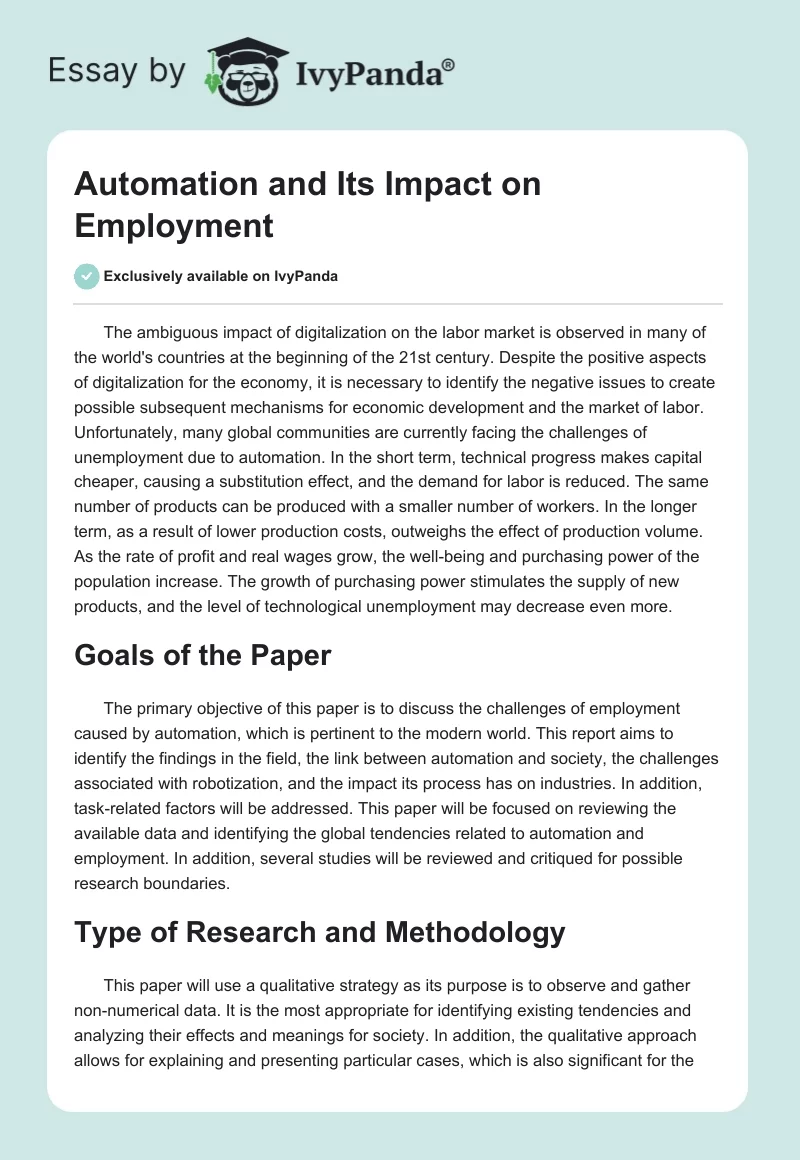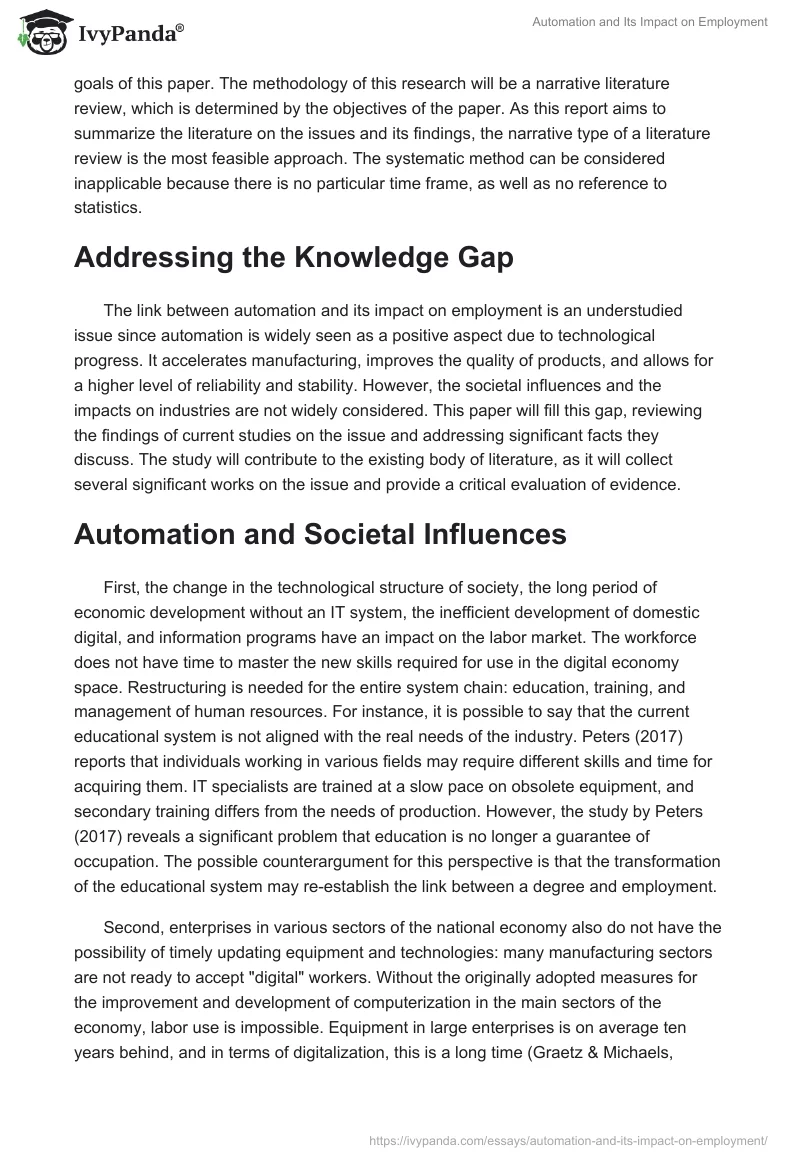The ambiguous impact of digitalization on the labor market is observed in many of the world’s countries at the beginning of the 21st century. Despite the positive aspects of digitalization for the economy, it is necessary to identify the negative issues to create possible subsequent mechanisms for economic development and the market of labor. Unfortunately, many global communities are currently facing the challenges of unemployment due to automation. In the short term, technical progress makes capital cheaper, causing a substitution effect, and the demand for labor is reduced. The same number of products can be produced with a smaller number of workers. In the longer term, as a result of lower production costs, outweighs the effect of production volume. As the rate of profit and real wages grow, the well-being and purchasing power of the population increase. The growth of purchasing power stimulates the supply of new products, and the level of technological unemployment may decrease even more.
Goals of the Paper
The primary objective of this paper is to discuss the challenges of employment caused by automation, which is pertinent to the modern world. This report aims to identify the findings in the field, the link between automation and society, the challenges associated with robotization, and the impact its process has on industries. In addition, task-related factors will be addressed. This paper will be focused on reviewing the available data and identifying the global tendencies related to automation and employment. In addition, several studies will be reviewed and critiqued for possible research boundaries.
Type of Research and Methodology
This paper will use a qualitative strategy as its purpose is to observe and gather non-numerical data. It is the most appropriate for identifying existing tendencies and analyzing their effects and meanings for society. In addition, the qualitative approach allows for explaining and presenting particular cases, which is also significant for the goals of this paper. The methodology of this research will be a narrative literature review, which is determined by the objectives of the paper. As this report aims to summarize the literature on the issues and its findings, the narrative type of a literature review is the most feasible approach. The systematic method can be considered inapplicable because there is no particular time frame, as well as no reference to statistics.
Addressing the Knowledge Gap
The link between automation and its impact on employment is an understudied issue since automation is widely seen as a positive aspect due to technological progress. It accelerates manufacturing, improves the quality of products, and allows for a higher level of reliability and stability. However, the societal influences and the impacts on industries are not widely considered. This paper will fill this gap, reviewing the findings of current studies on the issue and addressing significant facts they discuss. The study will contribute to the existing body of literature, as it will collect several significant works on the issue and provide a critical evaluation of evidence.
Automation and Societal Influences
First, the change in the technological structure of society, the long period of economic development without an IT system, the inefficient development of domestic digital, and information programs have an impact on the labor market. The workforce does not have time to master the new skills required for use in the digital economy space. Restructuring is needed for the entire system chain: education, training, and management of human resources. For instance, it is possible to say that the current educational system is not aligned with the real needs of the industry. Peters (2017) reports that individuals working in various fields may require different skills and time for acquiring them. IT specialists are trained at a slow pace on obsolete equipment, and secondary training differs from the needs of production. However, the study by Peters (2017) reveals a significant problem that education is no longer a guarantee of occupation. The possible counterargument for this perspective is that the transformation of the educational system may re-establish the link between a degree and employment.
Second, enterprises in various sectors of the national economy also do not have the possibility of timely updating equipment and technologies: many manufacturing sectors are not ready to accept “digital” workers. Without the originally adopted measures for the improvement and development of computerization in the main sectors of the economy, labor use is impossible. Equipment in large enterprises is on average ten years behind, and in terms of digitalization, this is a long time (Graetz & Michaels, 2018). However, the data can be critiqued for the lack of measurements used for large and medium companies. In addition, it is possible to argue that not all equipment is outdated; otherwise, it would not be possible to ensure significant productivity growth. In the conditions of digitalization, modern workplaces should not only be created promptly but also be able to transform, taking into account time and technological tasks.
Third, the introduction of automated systems and robots into production cycles increases the risk of rising unemployment, which is especially relevant to individuals having relatively low skills. Artificial intelligence development can increase inequality in the labor market and help reduce jobs. Enterprises must calculate the benefits of the introduction of robots and compare them with the cost of their acquisition and the price of human labor. For example, Autor (2015) reports that automation may increase the number of jobs lost and prevent the economy from creating new ones. These data illustrate the need for preparatory measures to reduce the ramifications of automation. However, the research estimations are based on the current technological progression. The possible counterargument to this study is that, in many cases, automation does not reduce the employment rate significantly, as the implementation of technologies requires the assistance of people. Nevertheless, Autor’s arguments can be considered reasonable because machine-human substitution has become a rising problem.
Automation and Industries
The main task of industrial robots is the replacement of monotonous human labor and people working in hazardous industries, increasing speed and accuracy. Automation is used in various sectors, including manufacturing and healthcare. The automotive industry, which integrates robotic systems of welding and painting, is the key customer. Moreover, robots are also integrated into electronics and electrical engineering, metal production, plastics, pharmaceutical, and food processing (Arntz, Gregory, & Zierahn, 2016). The possible counterargument is that this study fails to specify the degree of implementation of robotics, which means that its claims may only be partially relevant.
It is possible to say that when a person is replaced with a machine, the economy receives an incentive in the development of innovations. Freeing up workers can upgrade their skills and engage in more complex or more creative work in their field – from this perspective, humans are not at risk of being replaced by robots (Diamond, 2018). However, it is possible to argue that these estimates are based on a small sample of factories, which leads to skewed timeframes, while the utilization of robots should be controlled strictly.
There are both negative and positive aspects of robotics introduction. Advantages are that it facilitates the labor of workers, reduces labor intensity and the cost of finished products, as well as increases productivity and production volumes. Disadvantages are that it requires high qualification of service technicians, and it is difficult to find personnel. In addition, there is already a growing demand for technologically literate personnel, which may be challenging for some individuals (McClure, 2018). However, such an issue is not caused by the implementation of robotics specifically but is rather linked to the increased use of technology in general.
Robotization and Tasks
Robots are most widely used in industries with value-added sectors, such as the automotive industry, electronics, or agriculture. There is an assumption that at the stage of mass robotization, the flow of jobs from the manufacturing sector to the services sector will increase. At the same time, women will suffer more than men, since there are far fewer technical specialists, programmers, and mathematicians among them, who are becoming more and more popular today. In addition, technological progress has contributed to the increased gap among the economically advantaged and disadvantaged groups of the population. Rotman (2013) reports that automation affects high-skilled workers negatively too, decreasing their income significantly. However, the possible counterargument is that technologies may make the tasks of many employees easier and save their time.
Conclusion
The studies show that digitalization has a multidimensional effect on the labor market. The paper reveals factors that influence the distribution of population on jobs, the current state of the labor market, production, and robotics. Many questions, such as the decreased role of education and increased unemployment, have started to arise. These findings suggest that the methodology used for the research was effective as it served its purpose of identifying the effects of automation from the perspective of society, tasks, and industries. It is necessary to solve the problems of production infrastructure and quality of labor resources.
References
Arntz, M., Gregory, T., & Zierahn, U. (2016). The risk of automation for jobs in OECD countries. OECD Social, Employment and Migration Working Papers, 1(189), 4–25.
Autor, D. H. (2015). Why are there still so many jobs? The history and future of workplace automation. American Economic Association, 29(3), 3–30.
Diamond, A. M. (2018). Robots and computers enhance us more than they replace us. The American Economist, 1(1), 2-5.
Graetz, G., & Michaels, G. (2018). Robots at work. The Review of Economics and Statistics, 100(5), 753–768.
McClure, P. K. (2018). “You’re Fired,” says the robot: The rise of automation in the workplace, technophobes, and fears of unemployment. Social Science Computer Review, 36(2), 139–156.
Peters, M. A. (2017). Technological unemployment: Educating for the fourth industrial revolution. Educational Philosophy and Theory, 49(1), 1-6.
Rotman, D. (2013). How technology is destroying jobs. MIT Technology Review Magazine, 116(4), 29–35.


